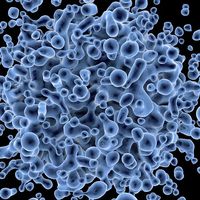Novel Spatial Technologies Used to Investigate the Tumor Landscape
New technologies are rapidly transforming the way scientists study disease, particularly cancer. Due to unique biological characteristics of solid tumors, technology that aids in identifying gene expression of cancer cells, as well as cells in the surrounding environment is not only helpful, but integral in expanding the field’s knowledge of tumor function. Therefore, advanced technology has the potential to improve not just our understanding of tumor behavior but provides the power to help characterize tumors in individual patients to effectively improve patient-specific treatment.
A recent article in Nature Immunology from Drs. Logan Walsh and Daniela Quail describes the use of spatial technology in cancer research. Both researchers study the role of the tumor microenvironment (TME) in tumor progression, and are from the Rosalind and Morris Goodman Cancer Center, McGill University. Previously transcriptomic technology, in general terms, was the optimal analysis to perform. Transcriptomics provided the researcher with the ability to identify all the cells in the TME and look at their gene expression. This allowed scientists to see which genes are expressed or downregulated in cells with or without a therapy and in other contexts dependent on the researcher’s question. Transcriptomic analysis is still extremely helpful and provides insight into the TME, but an additional rising component includes spatial analysis that indicate where these cells are in the TME. There are many strengths of this new analysis and both Walsh and Quail explore these in their article.
Spatial technology in addition to transcriptomic data allows scientists to uncover tumor-immune cell interactions in different contexts. This new technology also has the ability to analyze receptor clones on different immune cells such as B and T cells. For example, a method known as T cell receptor (TCR) – sequencing was conducted on lung tumors from a study called the Tracking Cancer Evolution through Therapy (TRACERx) project. Through spatial technology, it was concluded that TCRs within TMEs were significantly different between patients and tumor regions. Spatial imaging can also help in histology by using metals to tag protein targets in a tissue to determine where proteins reside. The impact of spatial analysis, including mass spectrometry imaging (MSI) has led to the publication of papers outlining the heterogeneity of different tumors and specific differences between patient samples. Finally, another key strength Walsh and Quail outline include the advantage of metabolite profiling of cells within the TME using specific MSI techniques to determine the distribution of lipids and other metabolic molecules in the context of cancer. Overall, spatial technology has the ability to provide various details about cell-to-cell interaction in the TME.
Walsh and Quail outline the benefits of spatial technology and how it has the potential to improve our understanding of cell-to-cell interactions within the TME. More importantly, they discuss future opportunities with artificial intelligence (AI) and how combining spatial technology with big patient datasets can provide a comprehensive picture of what is going on in the TME. It is important to weigh out the strengths of these rising technologies and how to best use them to achieve optimal therapeutic treatment for patients. Through spatial technology and the addition of other techniques, scientists and physicians can more effectively analyze the TME in patients for more targeted therapies, improving personalized medicine.
Article, Nature Immunology, Logan Walsh, Daniela Quail, Rosalind and Morris Goodman Cancer Center, McGill University, Tracking Cancer Evolution through Therapy (TRACERx) project








